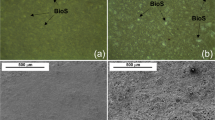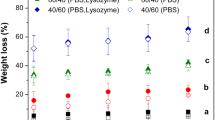Abstract
The present study describes the preparation of extracellular matrix (ECM; from porcine omentum) based chitosan composite films for wound dressing applications. The films were prepared by varying the ECM content, whereas, the amount of chitosan was kept constant. The interactions amongst the components of the films were analyzed by FTIR and XRD studies. The films were thoroughly characterized for surface hydrophilicity, moisture retention capability, water vapor permeability, mechanical and biocompatibility. FTIR study indicated that both chitosan and ECM were present in their native form and did not lose their activity. XRD analysis suggested composition dependent change in the crystallinity of the films. The mechanical properties suggested that the composite films had sufficient properties to be used for wound dressing applications. An increase in the ECM content resulted in better hydrophilicity of the films and hence better the moisture retention capacity and retardant water vapor transmission rate property of the composite films. The films were found to be biocompatible to both blood and adipose tissue derived stem cells. In gist, the prepared films may be explored as wound dressing materials.





Similar content being viewed by others
References
Archana D, et al. Chitosan-PVP-nano silver oxide wound dressing: in vitro and in vivo evaluation. Int J Biol Macromol. 2015;73:49–57.
Boateng JS, et al. Wound healing dressings and drug delivery systems: a review. J Pharm Sci. 2008;97(8):2892–923.
Hanna JR, Giacopelli JA. A review of wound healing and wound dressing products. J Foot Ankle Surg. 1997;36(1):2–14.
Murphy PS, Evans GR. Advances in wound healing: a review of current wound healing products. Plastic Surg Int. 2012.
Bolton L, Monte K, Pirone L. Moisture and healing: beyond the jargon. Ostomy/wound Manag. 2000; 46(1A Suppl): 51S–62S; quiz 63S-64S.
Crapo PM, Gilbert TW, Badylak SF. An overview of tissue and whole organ decellularization processes. Biomaterials. 2011;32(12):3233–43.
Rosario DJ, et al. Decellularization and sterilization of porcine urinary bladder matrix for tissue engineering in the lower urinary tract. Regen Med. 2008;3:145–56.
Brett D. A review of collagen and collagen-based wound dressings. Wounds-A compendium of clinical research and practice. 2008;20(12):347–56.
Sorokin L. The impact of the extracellular matrix on inflammation. Nat Rev Immunol. 2010;10(10):712–23.
Cartier R, et al. Angiogenic factor: a possible mechanism for neovascularization produced by omental pedicles. J Thorac Cardiovasc Surg. 1990;99(2):264–8.
Saltz R, et al. Laparoscopically harvested omental free flap to cover a large soft tissue defect. Ann Surg. 1993;217(5):542.
Azad AK, et al. Chitosan membrane as a wound-healing dressing: characterization and clinical application. J Biomed Mater Res B Appl Biomater. 2004;69(2):216–22.
Zhu Y, et al. Collagen–chitosan polymer as a scaffold for the proliferation of human adipose tissue-derived stem cells. J Mater Sci Mater Med. 2009;20(3):799–808.
Xu H, et al. Chitosan–hyaluronic acid hybrid film as a novel wound dressing: in vitro and in vivo studies. Polym Adv Technol. 2007;18(11):869–75.
Gu Z, et al. Preparation of chitosan/silk fibroin blending membrane fixed with alginate dialdehyde for wound dressing. Int J Biol Macromol. 2013;58:121–6.
Nguyen VC, Nguyen VB, Hsieh M-F. Curcumin-loaded chitosan/gelatin composite sponge for wound healing application. Int J Polym Sci. 2013.
Kratz G, et al. Heparin-chitosan complexes stimulate wound healing in human skin. Scand J Plast Reconstr Surg Hand Surg. 1997;31(2):119–23.
Woessner J. The determination of hydroxyproline in tissue and protein samples containing small proportions of this imino acid. Arch Biochem Biophys. 1961;93(2):440–7.
Kesava Reddy G, Enwemeka CS, Reddy Kesava. A simplified method for the analysis of hydroxyproline in biological tissues. Clin Biochem. 1996;29(3):225–9.
Zivanovic S, et al. Physical, mechanical, and antibacterial properties of chitosan/PEO blend films. Biomacromolecules. 2007;8(5):1505–10.
Patricia Miranda S, et al. Water vapor permeability and mechanical properties of chitosan composite films. J Chil Chem Soc. 2004;49(2):173–8.
Pal K, Pal S. Development of porous hydroxyapatite scaffolds. Mater Manuf Process. 2006;21(3):325–8.
AbdElhady M. Preparation and characterization of chitosan/zinc oxide nanoparticles for imparting antimicrobial and UV protection to cotton fabric. Int J Carbohydr Chem. 2012.
Sundarrajan P, et al. One pot synthesis and characterization of alginate stabilized semiconductor nanoparticles. Bull Korean Chem Soc. 2012;33(10):3218–24.
Sarasua J, et al. Crystallinity assessment and in vitro cytotoxicity of polylactide scaffolds for biomedical applications. J Mater Sci Mater Med. 2011;22(11):2513–23.
Cui H, Sinko PJ. The role of crystallinity on differential attachment/proliferation of osteoblasts and fibroblasts on poly (caprolactone-co-glycolide) polymeric surfaces. Front Mater Sci. 2012;6(1):47–59.
Bellido G, Hatcher D. Asian noodles: revisiting Peleg’s analysis for presenting stress relaxation data in soft solid foods. J Food Eng. 2009;92(1):29–36.
Wu Y-B, et al. Preparation and characterization on mechanical and antibacterial properties of chitsoan/cellulose blends. Carbohydr Polym. 2004;57(4):435–40.
Qu X-H, Wu Q, Chen G-Q. In vitro study on hemocompatibility and cytocompatibility of poly (3-hydroxybutyrate-co-3-hydroxyhexanoate). J Biomater Sci Polym Ed. 2006;17(10):1107–21.
Jung Y, McCarty JH. Band 4.1 proteins regulate integrin-dependent cell spreading. Biochem Biophys Res Commun. 2012;426(4):578–84.
Acknowledgments
The authors are thankful to MHRD, DBT and DST, Govt. of India for providing research facility through center of excellence on Tissue Engineering, through program support on Tissue Engineering research and individual projects respectively.
Author information
Authors and Affiliations
Corresponding author
Ethics declarations
Conflict of interest
All the authors declare no conflict of interest.
Electronic supplementary material
Below is the link to the electronic supplementary material.
Rights and permissions
About this article
Cite this article
Asthana, S., Goyal, P., Dhar, R. et al. Evaluation extracellular matrix–chitosan composite films for wound healing application. J Mater Sci: Mater Med 26, 220 (2015). https://doi.org/10.1007/s10856-015-5551-y
Received:
Accepted:
Published:
DOI: https://doi.org/10.1007/s10856-015-5551-y




